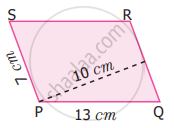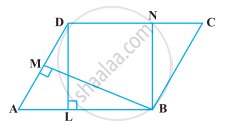Advertisements
Advertisements
प्रश्न
The table given below contains some measures of the rectangle. Find the unknown values.
| Length | Breadth | Perimeter | Area |
| ? | 15 cm | 60 cm | ? |
उत्तर
b = 15 cm
p = 60 cm
p = 2 (l + b) units
60 = 2(l + 15) cm
`60/2` = l + 15
30 = l + 15
l = 30 – 15
l = 15 cm
Area = l × b unit2
= 15 × 15 cm2
= 225 cm2
A = 225 cm2
Completing the unknown values in the table.
| Length | Breadth | Perimeter | Area |
| 15 cm | 15 cm | 60 cm | 225 cm2 |
APPEARS IN
संबंधित प्रश्न
ABCD is a parallelogram. E is a point on BA such that BE = 2 EA and F is a point on DC
such that DF = 2 FC. Prove that AE CF is a parallelogram whose area is one third of the
area of parallelogram ABCD.
In a ΔABC, D, E, F are the mid-points of sides BC, CA and AB respectively. If ar (ΔABC) = 16cm2, then ar (trapezium FBCE) =
Find the area of a rectangle whose length = 3.6 m breadth = 90 cm
What will happen to the area of a rectangle, if its length and breadth both are trebled?
Find the area and perimeter of the following parallelograms
Measure the length of the floor of your classroom in meters. Also measure the width.
- If you want to move around easily then how many children do you think should be there in one square meter?
In the following figure, the area of parallelogram ABCD is ______.

An engineer who plans to build a compound wall on all sides of a house must find the area of the compound.
Find the area of the following figure by counting squares:

Find the area of the following figure by counting squares:

